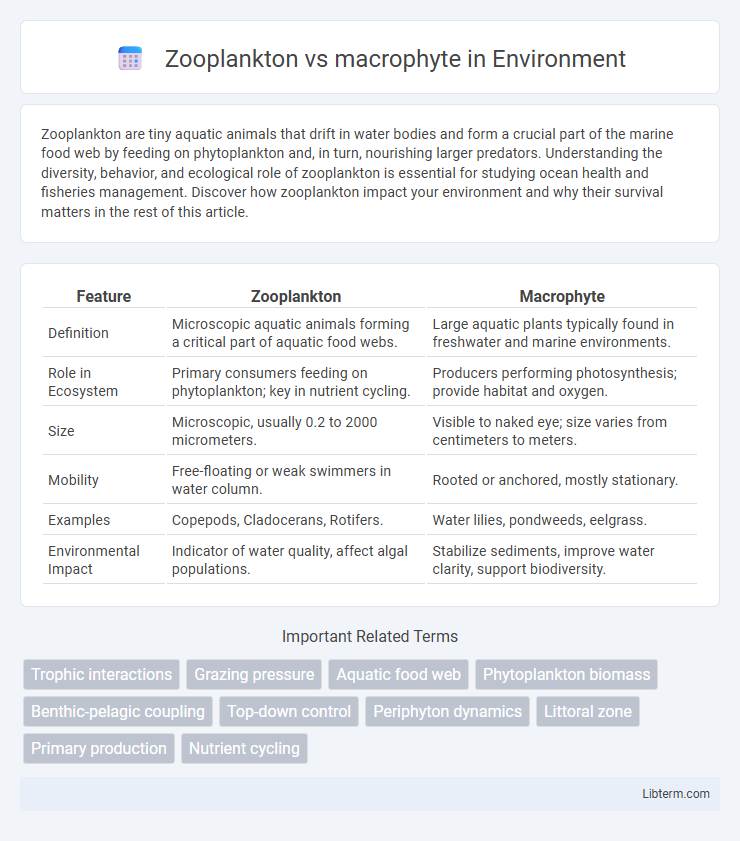Zooplankton are tiny aquatic animals that drift in water bodies and form a crucial part of the marine food web by feeding on phytoplankton and, in turn, nourishing larger predators. Understanding the diversity, behavior, and ecological role of zooplankton is essential for studying ocean health and fisheries management. Discover how zooplankton impact your environment and why their survival matters in the rest of this article.
Table of Comparison
| Feature | Zooplankton | Macrophyte |
|---|---|---|
| Definition | Microscopic aquatic animals forming a critical part of aquatic food webs. | Large aquatic plants typically found in freshwater and marine environments. |
| Role in Ecosystem | Primary consumers feeding on phytoplankton; key in nutrient cycling. | Producers performing photosynthesis; provide habitat and oxygen. |
| Size | Microscopic, usually 0.2 to 2000 micrometers. | Visible to naked eye; size varies from centimeters to meters. |
| Mobility | Free-floating or weak swimmers in water column. | Rooted or anchored, mostly stationary. |
| Examples | Copepods, Cladocerans, Rotifers. | Water lilies, pondweeds, eelgrass. |
| Environmental Impact | Indicator of water quality, affect algal populations. | Stabilize sediments, improve water clarity, support biodiversity. |
Introduction to Zooplankton and Macrophytes
Zooplankton are microscopic animals drifting in aquatic environments, playing a crucial role in the food web by consuming phytoplankton and transporting energy to higher trophic levels. Macrophytes are aquatic plants, including submerged, floating, and emergent species, that provide habitat structure, improve water quality through nutrient uptake, and support biodiversity. Both zooplankton and macrophytes are essential components of freshwater and marine ecosystems, influencing nutrient cycling and ecosystem stability.
Key Characteristics of Zooplankton
Zooplankton are microscopic, free-floating organisms crucial to aquatic ecosystems, serving as primary consumers by feeding on phytoplankton and bacteria. They exhibit diverse forms, including crustaceans like copepods, and possess adaptations such as transparent bodies and vertical migration to evade predators. Unlike macrophytes, which are rooted aquatic plants performing photosynthesis, zooplankton rely on organic matter consumption for energy and play a vital role in nutrient cycling and energy transfer in food webs.
Defining Traits of Aquatic Macrophytes
Aquatic macrophytes are large, multicellular plants adapted to live in or near water, characterized by rooted structures or floating leaves that enable photosynthesis in submerged environments. Unlike zooplankton, which are microscopic and motile animal plankton, macrophytes exhibit complex morphology including stems, leaves, and reproductive organs, vital for oxygen production and habitat formation in aquatic ecosystems. Their ability to stabilize sediments and absorb nutrients distinguishes them as primary producers crucial for maintaining water clarity and supporting biodiversity.
Ecological Roles in Aquatic Ecosystems
Zooplankton serve as primary consumers that regulate phytoplankton populations and transfer energy to higher trophic levels, playing a crucial role in aquatic food webs. Macrophytes contribute to habitat complexity, enhance water quality through nutrient uptake, and provide refuge and breeding grounds for fish and invertebrates. Both zooplankton and macrophytes are essential for maintaining ecological balance, supporting biodiversity, and sustaining ecosystem productivity in freshwater and marine environments.
Interactions Between Zooplankton and Macrophytes
Zooplankton and macrophytes interact through complex ecological relationships where macrophytes provide habitat and refuge, influencing zooplankton distribution and abundance in aquatic ecosystems. Macrophyte beds offer shelter from predators, enhancing zooplankton survival rates and promoting biodiversity by creating microhabitats with varying light and nutrient conditions. These interactions regulate nutrient cycling and energy flow, as zooplankton consume phytoplankton and detritus within the macrophyte zones, contributing to the overall health and stability of freshwater and marine environments.
Impacts on Water Quality and Clarity
Zooplankton play a crucial role in enhancing water clarity by grazing on phytoplankton, which reduces algal blooms and prevents eutrophication. Macrophytes contribute to water quality by stabilizing sediments, absorbing excess nutrients, and providing oxygen through photosynthesis, which supports aquatic ecosystems. Both zooplankton and macrophytes are vital for maintaining balanced nutrient cycles and improving overall water transparency in freshwater environments.
Contributions to the Food Web
Zooplankton play a crucial role in aquatic food webs by consuming phytoplankton and serving as a primary food source for fish and other higher trophic levels. Macrophytes contribute by providing habitat and shelter for various invertebrates and small fish, supporting biodiversity and nutrient cycling in aquatic ecosystems. Together, zooplankton and macrophytes create interconnected networks that sustain energy flow and enhance ecosystem productivity.
Adaptations to Environmental Changes
Zooplankton exhibit rapid adaptability to environmental changes through physiological plasticity, enabling them to alter feeding, reproduction, and migration patterns in response to temperature fluctuations and predation pressure. Macrophytes adapt through morphological and biochemical changes, such as altering leaf size, thickness, and production of secondary metabolites to cope with varying light availability and nutrient levels. Both organisms possess unique adaptive strategies that support ecosystem resilience amid dynamic aquatic environments.
Human Influences and Management Strategies
Human activities such as nutrient runoff and habitat alteration significantly impact zooplankton and macrophyte populations, often leading to imbalanced aquatic ecosystems. Effective management strategies include reducing agricultural runoff, implementing buffer zones, and restoring native vegetation to control nutrient levels and maintain biodiversity. Monitoring programs and adaptive management practices are crucial to mitigate human-induced stress and promote sustainable coexistence of zooplankton and macrophytes.
Future Research Directions and Conservation
Future research on zooplankton and macrophyte interactions should emphasize ecosystem resilience under climate change and nutrient loading scenarios. Investigating the roles of macrophytes in providing habitat complexity for zooplankton can enhance conservation strategies targeting biodiversity preservation. Developing models that integrate zooplankton population dynamics with macrophyte growth patterns will improve management approaches for aquatic ecosystems.
Zooplankton Infographic

 libterm.com
libterm.com